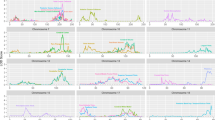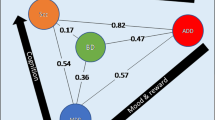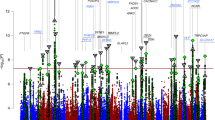Abstract
Bipolar affective disorder is a severe mood disorder that afflicts approximately 1% of the population worldwide. Twin and adoption studies have indicated that genetic factors contribute to the disorder and while many chromosomal regions have been implicated, no susceptibility genes have been identified. We undertook a combined analysis of 10 cM genome screen data from a single large bipolar affective disorder pedigree, for which we have previously reported linkage to chromosome 13q14 (Badenhop et al, 2001) and 12 pedigrees independently screened using the same 400 microsatellite markers. This 13-pedigree cohort consisted of 231 individuals, including 69 affected members. Two-point LOD score analysis was carried out under heterogeneity for three diagnostic and four genetic models. Non-parametric multipoint analysis was carried out on regions of interest. Two-point heterogeneity LOD scores (HLODs) greater than 1.5 were obtained for 11 markers across the genome, with HLODs greater than 2.0 obtained for four of these markers. The strongest evidence for linkage was at 3q25–26 with a genome-wide maximum score of 2.49 at D3S1279. Six markers across a 50 cM region at 3q25–26 gave HLODs greater than 1.5, with three of these markers producing scores greater than 2.0. Multipoint analysis indicated a 20 cM peak between markers D3S1569 and D3S1614 with a maximum NPL of 2.8 (P= 0.004). Three other chromosomal regions yielded evidence for linkage: 9q31–q33, 13q14 and 19q12–q13. The regions on chromosomes 3q and 13q have previously been implicated in other bipolar and schizophrenia studies. In addition, several individual pedigrees gave LOD scores greater than 1.5 for previously reported bipolar susceptibility loci on chromosomes 18p11, 18q12, 22q11 and 8p22–23.
This is a preview of subscription content, access via your institution
Access options
Subscribe to this journal
Receive 12 print issues and online access
$259.00 per year
only $21.58 per issue
Buy this article
- Purchase on Springer Link
- Instant access to full article PDF
Prices may be subject to local taxes which are calculated during checkout




Similar content being viewed by others
References
Weissman MM, Bland RC, Canino GJ, Faravelli C, Greenwald S, Hwu HG et al. Cross-national epidemiology of major depression and bipolar disorder J Am Med Assoc 1996 276: 293–299
Murray CJT, Lopez AD . Global mortality, disability and the contribution of risk factors: Global Burden of Disease Study Lancet 1997 349: 1436–1442
Kelsoe JR . The genetics of bipolar disorder Psychiatr Ann 1997 27: 285–292
MacKinnon DE, Jamison KR, DePaulo JR . Genetics of manic depressive illness Ann Rev Neurosci 1997 20: 355–373
Blackwood DH, He L, Morris SW, McLean A, Whitton C, Thomson M et al. A locus for bipolar disorder on chromosome 4p Nat Genet 1996 12: 427–430
Craddock N, Owen M, Burge S, Kurina B, Thomas P, McGuffin P . Familial cosegregation of major affective disorder and Darier's Disease (keratosis follicularis) Br J Psychiatry 1994 164: 355–358
Stine OC, Xu J, Kosela R, McMahon FJ, Geschwind M, Friddle C et al. Evidence for linkage of bipolar disorder to chromosome 18 with a parent-of-origin effect Am J Hum Genet 1995 57: 1384
Berretini WH, Ferraro TN, Goldin LR et al. Pericentromeric chromosome 18 DNA markers and manic-depressive illness: evidence for a susceptibility gene Proc Natl Acad Sci 1994 91: 5918–5921
Straub RE, Leher T, Luo Y, Loth JE, Shao W, Sharpe L et al. A possible vulnerability locus for bipolar affective disorder on chromosome 21q22.3 Nat Genet 1994 8: 291–296
Kelsoe JR, Spence MA, Loetscher E, Foguet M, Sadovnick AD, Remick RA et al. A genome survey indicates a possible susceptibility locus for bipolar disorder on chromosome 22 Proc Natl Acad Sci 2001 98: 585–590
Adams LJ, Mitchell PB, Fielder SL, Rosso A, Donald JA, Schofield PR . A susceptibility locus for bipolar affective disorder on chromosome 4q35 Am J Hum Genet 1998 62: 1084–1091
Badenhop RF, Moses MJ, Scimone A, Mitchell PB, Ewen KR, Rosso A et al. A genome screen of a large bipolar affective disorder pedigree supports evidence for a susceptibility locus on chromosome 13q Mol Psychiatry 2001 6: 396–403
Friddle C, Koskela R, Ranade K, Hebert J, Cargill M, Clark CD et al. Full-genome scan for linkage in 50 families segregating the bipolar affective disease phenotype Am J Hum Genet 2000 66: 205–215
Bennett P, Bort S, Seguardo R, Middle F, Jones I, Heron J et al. The Wellcome Trust UK-Irish bipolar sib-pair genome screen: complete first stage data and second stage progress report Am J Med Genet 2000 96: 467
Ginns EI, St Jean P, Philibert RA, Galdzicka M, Damschroder-Williams P, Thiel B et al. A genome-wide search for chromosomal loci linked to mental health wellness in relatives at high risk for bipolar affective disorder among the Old Order Amish Proc Natl Acad Sci 1998 95: 15531–15536
Detera-Wadleigh SD, Badner JA, Berrettini WH, Yoshikawa T, Goldin LR, Turner G et al. A high-density genome scan detects evidence for a bipolar-disorder susceptibility locus on 13q32 and other potential loci on 1q32 and 18p11.2 Proc Nat Acad Sci USA 1999 96: 5604–5609
Ginns EI, Ott J, Egeland JA, Allen CR, Fann CSI, Pauls DL et al. A genome-wide search for chromosomal loci linked to bipolar affective disorder Nat Genet 1996 12: 413–435
Stine OC, McMahon FJ, Chen L, Xu J, Meyers DA, MacKinnon DF et al. Initial genome screen for bipolar disorder in the NIMH genetics initiative pedigrees: chromosomes 2, 11, 13, 14, and X Am J Med Genet 1997 74: 263–269
Brzustowicz LM, Honer WG, Chow EW, Little D, Hogan J, Hodgkinson K et al. Linkage of familial schizophrenia to chromosome 13q32 Am J Hum Genet 1999 65: 1096–1103
Lin MW, Curtis D, Williams N, Arranz M, Nanko S, Collier D et al. Suggestive evidence for linkage of schizophrenia to markers on chromosome 13q14 1 Psychiatr Genet 1995 5: 117–126
Blouin JL, Dombroski BA, Nath SK, Lasseter VK, Wolyniec PS, Nestadt G et al. Schizophrenia susceptibility loci on chromosome 13q32 and 8p21 Nat Genet 1998 20: 70–73
Nurnberger JI Jr, Blehar MC, Kaufman CA, York-Cooler C, Simpson SG, Harkavy-Friedman J et al. Diagnostic interview for genetic studies: rationale, unique features, and training: NIMH Genetics Initiative Arch Gen Psychiatry 1994 51: 849–859
O”Connell JR, Weeks DE . PedCheck: a program for identifying marker typing incompatibilities in linkage analysis Am J Hum Genet 1998 63: 259–266
Terwilliger J . ANALYZE 1996 ftp://linkage.cpmc.columbia.edu/software/analyze
Ott J . Computer-simulation methods in human linkage analysis Proc Natl Acad Sci USA 1989 86: 4175–4178
Weeks DE, Ott J, Lathrop GM . SLINK: a general simulation program for linkage analysis Am J Hum Genet 1990 47: A204 (supplement)
Kruglyak L, Daly MJ, Reeve-Daly MP, Lander ES . Parametric and nonparametric linkage analysis: a unified mulipoint approach Am J Hum Genet 1996 58: 1347–1363
Risch N, Giuffra L . Model misspecification and multipoint analysis Hum Hered 1992 42: 77–92
Foroud T, Castelluccio PF, Koller DL, Edenberg HJ, Miller M, Bowman E et al. Suggestive evidence of a locus on chromosome 10p using the NIMH genetics initiative bipolar affective disorder pedigrees Am J Med Genet 2000 96: 18–23
Lander E, Kruglyak L . Genetic dissection of complex traits: guidelines for interpreting and reporting linkage results Nat Genet 1995 11: 241–247
Pulver AE, Karayiorgou M, Wolyniec PS, Lasseter VK, Kasch L, Nestadt G et al. Sequential strategy to identify a susceptibility gene for schizophrenia: report of potential linkage on chromosome 22q12–q13.1 Am J Med Genet 1994 54: 36–43
Berrettini WH . Are schizophrenic and bipolar disorders related? A review of family and molecular studies Biol Psychiatry 2000 48: 531–538
Detera-Wadleigh SD, Badner JA, Yoshikawa T, Sanders AR, Goldin LR, Turner G et al. Initital genome scan of the NIMH genetics initiative bipolar pedigrees: chromosomes 4, 7, 9, 18, 19, 20, and 21q Am J Med Genet 1997 74: 254–262
Nurnberger JI, DePaulo JR, Gershon ES, Reich T, Blehar MC, Edenberg HJ et al. Genomic survey of bipolar illness in the NIMH genetics initiative pedigrees: a preliminary report Am J Med Genet 1997 74: 227–237
Acknowledgements
We thank Jim McBride for development of a query database to aid in analysis of the linkage data, John Barlow and staff of the Australian Genome Research Facility, Melbourne, Australia and the family members who participated in this study. This study was supported by the National Health and Medical Research Council (Australia) via grants to the Garvan Institute of Medical Research (Block grant 993050), the Mood Disorders Unit, Prince of Wales Hospital (Program Grant 993208) and the Network of Brain Research into Mental Disorders (Unit Grant 983302).
Author information
Authors and Affiliations
Corresponding author
Rights and permissions
About this article
Cite this article
Badenhop, R., Moses, M., Scimone, A. et al. A genome screen of 13 bipolar affective disorder pedigrees provides evidence for susceptibility loci on chromosome 3 as well as chromosomes 9, 13 and 19. Mol Psychiatry 7, 594–603 (2002). https://doi.org/10.1038/sj.mp.4001025
Received:
Revised:
Accepted:
Published:
Issue Date:
DOI: https://doi.org/10.1038/sj.mp.4001025
Keywords
This article is cited by
-
GSK-3β Polymorphism Discriminates Bipolar Disorder and Schizophrenia: A Systematic Meta-Analysis
Molecular Neurobiology (2013)
-
Pedigree with frontotemporal lobar degeneration – motor neuron disease and Tar DNA binding protein-43 positive neuropathology: genetic linkage to chromosome 9
BMC Neurology (2008)
-
Chromosome 10q harbors a susceptibility locus for bipolar disorder in Ashkenazi Jewish families
Molecular Psychiatry (2008)
-
Genome-wide linkage scan of 98 bipolar pedigrees and analysis of clinical covariates
Molecular Psychiatry (2007)



